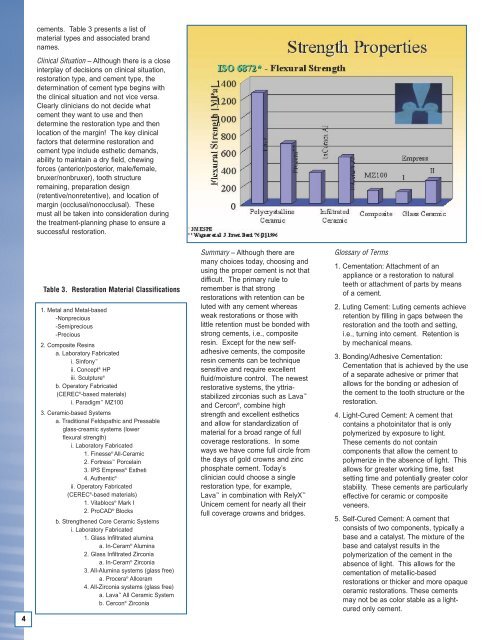Choosing and Using Permanent Luting Cements - Vision Dental ...
Choosing and Using Permanent Luting Cements - Vision Dental ...
Choosing and Using Permanent Luting Cements - Vision Dental ...
Create successful ePaper yourself
Turn your PDF publications into a flip-book with our unique Google optimized e-Paper software.
4<br />
cements. Table 3 presents a list of<br />
material types <strong>and</strong> associated br<strong>and</strong><br />
names.<br />
Clinical Situation – Although there is a close<br />
interplay of decisions on clinical situation,<br />
restoration type, <strong>and</strong> cement type, the<br />
determination of cement type begins with<br />
the clinical situation <strong>and</strong> not vice versa.<br />
Clearly clinicians do not decide what<br />
cement they want to use <strong>and</strong> then<br />
determine the restoration type <strong>and</strong> then<br />
location of the margin! The key clinical<br />
factors that determine restoration <strong>and</strong><br />
cement type include esthetic dem<strong>and</strong>s,<br />
ability to maintain a dry field, chewing<br />
forces (anterior/posterior, male/female,<br />
bruxer/nonbruxer), tooth structure<br />
remaining, preparation design<br />
(retentive/nonretentive), <strong>and</strong> location of<br />
margin (occlusal/nonocclusal). These<br />
must all be taken into consideration during<br />
the treatment-planning phase to ensure a<br />
successful restoration.<br />
Table 3. Restoration Material Classifications<br />
1. Metal <strong>and</strong> Metal-based<br />
-Nonprecious<br />
-Semiprecious<br />
-Precious<br />
2. Composite Resins<br />
a. Laboratory Fabricated<br />
i. Sinfony ii. Concept ® HP<br />
iii. Sculpture ®<br />
b. Operatory Fabricated<br />
(CEREC ® -based materials)<br />
i. Paradigm MZ100<br />
3. Ceramic-based Systems<br />
a. Traditional Feldspathic <strong>and</strong> Pressable<br />
glass-creamic systems (lower<br />
flexural strength)<br />
i. Laboratory Fabricated<br />
1. Finesse ® All-Ceramic<br />
2. Fortress Porcelain<br />
3. IPS Empress ® Estheti<br />
4. Authentic ®<br />
ii. Operatory Fabricated<br />
(CEREC ® -based materials)<br />
1. Vitablocs ® Mark I<br />
2. ProCAD ® Blocks<br />
b. Strengthened Core Ceramic Systems<br />
i. Laboratory Fabricated<br />
1. Glass Infiltrated alumina<br />
a. In-Ceram ® Alumina<br />
2. Glass Infiltrated Zirconia<br />
a. In-Ceram ® Zirconia<br />
3. All-Alumina systems (glass free)<br />
a. Procera ® Allceram<br />
4. All-Zirconia systems (glass free)<br />
a. Lava All Ceramic System<br />
b. Cercon ® Zirconia<br />
Summary – Although there are<br />
many choices today, choosing <strong>and</strong><br />
using the proper cement is not that<br />
difficult. The primary rule to<br />
remember is that strong<br />
restorations with retention can be<br />
luted with any cement whereas<br />
weak restorations or those with<br />
little retention must be bonded with<br />
strong cements, i.e., composite<br />
resin. Except for the new selfadhesive<br />
cements, the composite<br />
resin cements can be technique<br />
sensitive <strong>and</strong> require excellent<br />
fluid/moisture control. The newest<br />
restorative systems, the yttriastabilized<br />
zirconias such as Lava <br />
<strong>and</strong> Cercon ® , combine high<br />
strength <strong>and</strong> excellent esthetics<br />
<strong>and</strong> allow for st<strong>and</strong>ardization of<br />
material for a broad range of full<br />
coverage restorations. In some<br />
ways we have come full circle from<br />
the days of gold crowns <strong>and</strong> zinc<br />
phosphate cement. Today’s<br />
clinician could choose a single<br />
restoration type, for example,<br />
Lava in combination with RelyX <br />
Unicem cement for nearly all their<br />
full coverage crowns <strong>and</strong> bridges.<br />
Glossary of Terms<br />
1. Cementation: Attachment of an<br />
appliance or a restoration to natural<br />
teeth or attachment of parts by means<br />
of a cement.<br />
2. <strong>Luting</strong> Cement: <strong>Luting</strong> cements achieve<br />
retention by filling in gaps between the<br />
restoration <strong>and</strong> the tooth <strong>and</strong> setting,<br />
i.e., turning into cement. Retention is<br />
by mechanical means.<br />
3. Bonding/Adhesive Cementation:<br />
Cementation that is achieved by the use<br />
of a separate adhesive or primer that<br />
allows for the bonding or adhesion of<br />
the cement to the tooth structure or the<br />
restoration.<br />
4. Light-Cured Cement: A cement that<br />
contains a photoinitator that is only<br />
polymerized by exposure to light.<br />
These cements do not contain<br />
components that allow the cement to<br />
polymerize in the absence of light. This<br />
allows for greater working time, fast<br />
setting time <strong>and</strong> potentially greater color<br />
stability. These cements are particularly<br />
effective for ceramic or composite<br />
veneers.<br />
5. Self-Cured Cement: A cement that<br />
consists of two components, typically a<br />
base <strong>and</strong> a catalyst. The mixture of the<br />
base <strong>and</strong> catalyst results in the<br />
polymerization of the cement in the<br />
absence of light. This allows for the<br />
cementation of metallic-based<br />
restorations or thicker <strong>and</strong> more opaque<br />
ceramic restorations. These cements<br />
may not be as color stable as a lightcured<br />
only cement.


